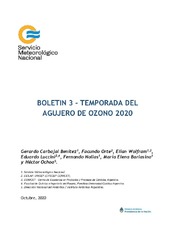Mostrar el registro sencillo del ítem
Boletín 3 - Temporada del Agujero de Ozono 2020
| dc.contributor.author | Carbajal Benítez, Gerardo | |
| dc.contributor.author | Orte, Facundo | |
| dc.contributor.author | Wolfram, Elián | |
| dc.contributor.author | Luccini, Eduardo | |
| dc.contributor.author | Nollas, Fernando Martín | |
| dc.contributor.author | Barlasina, María Elena | |
| dc.contributor.author | Ochoa, Héctor | |
| dc.date.accessioned | 2020-10-16T03:13:26Z | |
| dc.date.available | 2020-10-16T03:13:26Z | |
| dc.date.issued | 2020-10 | |
| dc.identifier.uri | http://hdl.handle.net/20.500.12160/1389 | |
| dc.description.abstract | El presente Boletín 3 del Agujero de Ozono, tiene por objetivo de establecer la evolución del Agujero de Ozono sobre la Antártida 2020. La temperatura de la estratosfera mínima media y zonal, se encuentran por debajo de la media del periodo 1979 al 2019 y las proyecciones muestran que están muy cerca de los valores mínimos históricos del mismo periodo (estratosfera fría), de tal manera que las Nubes Estratosféricas Polares estarán presentes, debido a que su área y volumen se encuentran cercanas a su máximo histórico, recordando que estas nubes, liberan principalmente cloro, que destruye al ozono. El flujo de calor, a través del movimiento de ondas atmosféricas, esta disminuido, es decir, se presenta con muy poca actividad, de tal manera que el transporte de calor desde la troposfera a la estratosfera, es muy pequeña. El vórtice polar se encuentra fortalecido y continua muy estable, por lo menos, hasta el 21 de octubre. Bajo estas condiciones, el Agujero de Ozono, se profundiza e intensifique la destrucción de ozono, siendo el mayor de esta década. Pero su tamaño, es muy parecido al del 2018 pero no superior al del 2015, es decir el segundo más grande de la década junto con el del año 2018. En cuanto a la radiación UV en la Antártida y Tierra del Fuego, aún es baja con Índice UV igual menor a 5 (moderado), pese a que en las Estaciones Antárticas de Belgrano II y San Martín, ya se encuentran en condiciones de Agujero de Ozono. | es |
| dc.description.abstract | This Bulletin No. 3 The Antarctic Ozone Hole 2020, has aims to establish the evolution of the Ozone Hole over Antarctica 2020. The mean, and zonal minimum stratosphere temperature are below the mean for the period 1979 to 2019, and the projections show that it is very close to the historical minimum values of the same period (cold stratosphere), in such a way that the Polar Stratospheric Clouds (PSC NEP) will be present, because their area, and volume are close to their historical maximum, these clouds release mainly chlorine, which destroys ozone. The heat flow, through the movement of atmospheric waves, is diminished, it occurs with very poor activity, in such a way that the transport of heat from the troposphere to the stratosphere is very small. The polar vortex is strengthened, and remains very stable, at least until October 21. Under these conditions, the Ozone Hole deepens, and intensifies the destruction of ozone, being the largest of this decade. But its size is very similar to that of 2018 but not higher than that of 2015, that is, the second largest of the decade along with that of 2018. As for UV radiation in Antarctica and Tierra del Fuego, it is still low With a UV Index equal to less than 5 (moderate), despite the fact that in the Antarctic Stations of Belgrano II and San Martín, they are already in Ozone Hole conditions. | en |
| dc.language.iso | spa | es |
| dc.publisher | Servicio Meteorológico Nacional. Dirección Nacional de Ciencia e Innovación en Productos y Servicios. Dirección Central de Monitoreo del Clima. | es |
| dc.subject | OZONO | es |
| dc.subject | ESTRATÓSFERA | es |
| dc.subject | ANTÁRTIDA | es |
| dc.title | Boletín 3 - Temporada del Agujero de Ozono 2020 | es |
| dc.type | Publicación seriada | es |
